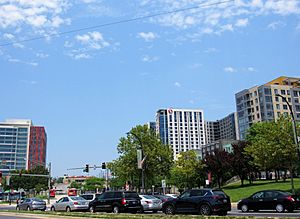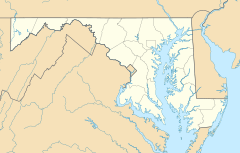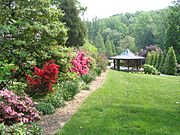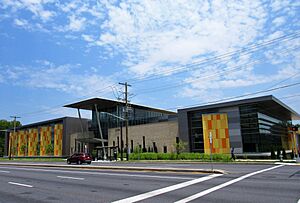Wheaton, Maryland facts for kids
Quick facts for kids
Wheaton, Maryland
|
|
|---|---|

Downtown Wheaton
|
|
| Country | |
| State | |
| County | |
| Area | |
| • Total | 6.94 sq mi (17.98 km2) |
| • Land | 6.90 sq mi (17.87 km2) |
| • Water | 0.04 sq mi (0.11 km2) |
| Elevation | 384 ft (117 m) |
| Population
(2020)
|
|
| • Total | 52,150 |
| • Density | 7,560.16/sq mi (2,919.09/km2) |
| Time zone | UTC−5 (Eastern (EST)) |
| • Summer (DST) | UTC−4 (EDT) |
| FIPS code | 24-83775 |
| GNIS feature ID | 2652342 |
Wheaton is a community in Montgomery County, Maryland, United States. It's located just north of Washington, D.C., and northwest of Silver Spring. Wheaton is named after Frank Wheaton (1833–1903). He was a brave general in the United States Army during the Civil War.
In 2020, about 52,150 people lived in Wheaton. The area has its own ZIP code (20902). However, the Wheaton Post Office is part of the larger Silver Spring postal system. Downtown Wheaton is found where Veirs Mill Road, University Boulevard, and Georgia Avenue meet.
Contents
Wheaton's History
Wheaton started as a small business area called Leesborough in 1826. It grew where three important roads met.
The Three Main Roads
- The first road was Brookeville Pike. It was a toll road that went from Washington, D.C. to Brookeville, Maryland. Today, it is known as Georgia Avenue.
- The second road was Veirs Mill Road. It was named after a mill built by Samuel Clark Veirs in 1838. This road connected to Rockville, Maryland, and then to the Potomac River.
- The third road was Old Bladensburg Road. Now called University Boulevard, it connected many towns. These towns included Georgetown, Bethesda, and Silver Spring.
Mitchell's Crossroads
Later, the business area became known as Mitchell's Crossroads. This name came from Robert T. Mitchell's tavern. The tavern was located at the corner of Union Turnpike (now Georgia Avenue) and Old Bladensburg Road (now University Boulevard).
During the Civil War, Confederate troops marched through this area. They were trying to invade Washington, D.C. Union General Frank Wheaton led his soldiers to defend Washington, D.C. They fought off the invasion at the Battle of Fort Stevens in 1864. The Confederate troops also retreated through Wheaton after their failed attack.
Mitchell's Tavern was believed to have been built around 1865. It stood until 1940, when it was destroyed by a fire.
After the Civil War

After the Civil War ended, George F. Plyer became the first postmaster in the area. In October 1869, Plyer, who was a war veteran, renamed the post office. He chose to honor his commanding officer, General Wheaton.
For many years after the Civil War, the Wheaton area was mostly farmland or undeveloped. In 1871, the first African American Church, Allen Chapel AME Church, was built. This church stayed in Wheaton until 2000. The New Creation Church then bought the property.
In the early 1900s, the area grew slowly. A few new businesses opened along the main roads. But after World War II, the capital region grew very fast. Wheaton also expanded quickly. The first modern post office opened in 1947. The Washington Suburban Sanitary Commission (WSSC) also added new water and sewer pipes. As part of this work, the large Glenmont Water Tower was built in 1947, just north of Wheaton.
Starting in 1948, Wheaton was steadily built up by developers. It became a modern suburb of Washington, D.C. Today, Wheaton is not an official city. It is managed by the government of Montgomery County. For some official records, Wheaton is considered a part of the larger Silver Spring area.
Wheaton's Population
| Historical population | |||
|---|---|---|---|
| Census | Pop. | %± | |
| 2010 | 48,284 | — | |
| 2020 | 52,150 | 8.0% | |
| source: 2010–2020 |
|||
In the 1950s, Wheaton had many new homes. These were bought by white, middle-class families. They included both blue-collar and white-collar workers. Now, many of these older homes are owned or rented by a diverse group of people.
| Year | Non-Hispanic White | Hispanic/Latino | Asian | Black | Multiracial |
|---|---|---|---|---|---|
| 1990 | 61% | 13% | 10% | 15% | |
| 2000 | 38% | 29% | 12% | 17% | 6% |
| 2010 | 26% | 42% | 12% | 18% | 5% |
| 2020 | 33.88% | 30.96% | 13.29% | 15.64% | 5.14% |
From 2010 to 2020, Wheaton's population was made up of different groups. About 23.8% were White. About 40.5% were Hispanic or Latino. About 18.5% were African American. And about 13.9% were Asian. Some people also identified as mixed-race.
Many people in Wheaton are immigrants. The largest groups come from El Salvador, Ethiopia, Vietnam, the Philippines, and Honduras. Between 2000 and 2010, Wheaton's Hispanic population grew a lot. It went from 29% to 42%.
Fun Things to Do in Wheaton
Wheaton has many cool places to visit.
- Wheaton Regional Park: This large park has a nature center and stables for horses. It also has a dog park and a picnic area. You can ride a carousel and a miniature train there. There's an athletic complex with indoor tennis, an ice rink, and ball fields.
- Brookside Gardens: Inside Wheaton Regional Park, you'll find Brookside Gardens. It's a beautiful 50-acre public garden with many different plants.
- Westfield Wheaton: In the 1960s, Wheaton Plaza was the biggest shopping center in the Maryland suburbs. Today, it's known as Westfield Wheaton.
- Wheaton Volunteer Rescue Squad: This is one of the busiest volunteer fire departments in Montgomery County. They respond to thousands of calls each year.
- Ethnic Restaurants: Wheaton has many different kinds of restaurants. This shows how diverse the community is.
- Wheaton Metro Station: The Red Line of the Washington Metro system serves Wheaton. The Wheaton station has the longest escalator in the Western Hemisphere. It is 508 feet (155 meters) long!
- First TV License: Wheaton is the highest point in the Washington, D.C., area. Because of this, it was home to the first television license in the United States. Charles Francis Jenkins started broadcasting from his home on July 2, 1928. His station's call sign was W3XK.
Other interesting places include:
- The Gilchrist Center for Cultural Diversity: This center helps the growing number of immigrants in Montgomery County. It opened in 2001.
- Wheaton Library and Recreation Center: This new building opened on September 8, 2019. It replaced the old library and youth center.
- Holy Cross Health Cancer Center: This center for cancer treatment opened on February 23, 2023.
Wheaton's Arts and Entertainment District
The State of Maryland has named Wheaton an Arts and Entertainment District. This means Wheaton joins Silver Spring and Bethesda with this special title in Montgomery County.
This special name helps artists and developers. Artists who work in the district get a tax break on their income. Developers who build places for artists to live and work can get a break on property taxes for up to 10 years. Also, these districts don't have to pay certain taxes on admissions and entertainment. This helps the arts grow in Wheaton!







